I pondered over platform fencing. The various plastic items available always appear to be too thick and chunky. Step forward Model Railway Scenery who produce a finely finished product, laser cut from .75mm greyboard. Yes, it's actually cardboard! My initial surprise was quickly overcome when I assembled the first piece however, as it makes up into a sturdy item. After all, you are not going to jump on the platform fencing, are you? In the pack you get 120cm of fencing, four ramp sections, and double and single gates.
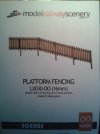
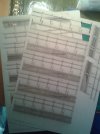
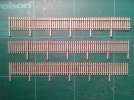
I gave the fencing a spray of some Humbrol light grey paint which I had to hand. On raiding the wife's crafting shed, under cover of darkness, and rummaging through her collection of acrylic paints, I came across one which was not far off the Southern Railway Light Stone which I was seeking. I smuggled out this paint together with a tube of white which was knocking about, just to lighten the other slightly.
I required a station building which would fit the very small area available, and decided to use Scalescenes' Small Station Building. It would take a small amount of work to make it into an acceptable Southern Railway building, Herewith a couple of photos of the finished building. Additions to the basic kit are plastic downpipes, white-metal chimney, Peco track pin door knobs, and a card valance. The posters and signs come with this excellent Scalescenes' kit..

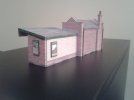
Houston, we have a problem! In my ignorance of all things Southern I assumed that Scalescenes' cream clapperboard, as included in the kit, would suffice for the station building, and I made the valance to match. And then the penny dropped. Having done a small piece of research and painting the platform fencing a light stone colour, I discovered that the cream clapperboard of the station building and valance was incorrect. These too should be finished in the same light stone colour. Fortunately, I always varnish the finished buildings with a matt varnish to protect the printer inks from moisture. Accordingly, it was a simple job to give a wash of the light stone without fear of the ink running. Here's the station building in its new colour..
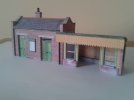
Terry



I gave the fencing a spray of some Humbrol light grey paint which I had to hand. On raiding the wife's crafting shed, under cover of darkness, and rummaging through her collection of acrylic paints, I came across one which was not far off the Southern Railway Light Stone which I was seeking. I smuggled out this paint together with a tube of white which was knocking about, just to lighten the other slightly.
I required a station building which would fit the very small area available, and decided to use Scalescenes' Small Station Building. It would take a small amount of work to make it into an acceptable Southern Railway building, Herewith a couple of photos of the finished building. Additions to the basic kit are plastic downpipes, white-metal chimney, Peco track pin door knobs, and a card valance. The posters and signs come with this excellent Scalescenes' kit..


Houston, we have a problem! In my ignorance of all things Southern I assumed that Scalescenes' cream clapperboard, as included in the kit, would suffice for the station building, and I made the valance to match. And then the penny dropped. Having done a small piece of research and painting the platform fencing a light stone colour, I discovered that the cream clapperboard of the station building and valance was incorrect. These too should be finished in the same light stone colour. Fortunately, I always varnish the finished buildings with a matt varnish to protect the printer inks from moisture. Accordingly, it was a simple job to give a wash of the light stone without fear of the ink running. Here's the station building in its new colour..

Terry



















 .
. 






























